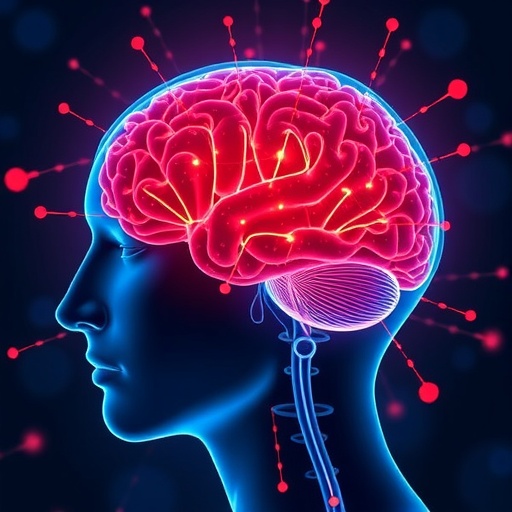Depressive disorders are alarmingly prevalent among individuals living with HIV, a reality that has significant implications for both mental health treatment and neurological research. A groundbreaking study recently published in BMC Psychiatry brings into sharp focus the structural brain changes observed in HIV-positive men who have sex with men (MSM) suffering from depression. This research offers unprecedented insights into the neurobiological substrates of depressive disorders comorbid with HIV, challenging conventional understandings and opening new avenues for scientific investigation and clinical intervention.
The study, conducted with a cohort of 69 HIV-positive MSM, meticulously divided subjects into two groups: those diagnosed with depressive disorders (PWH-DD) and those without (PWH controls). The researchers employed advanced neuroimaging techniques, specifically voxel-based and surface-based morphometry, to examine the gray matter volume (GMV) and cortical anatomical features embedded within structural magnetic resonance imaging (MRI) data. The findings are profound, revealing significant brain structural injury linked to depressive symptoms in the HIV-positive population.
Initially, the researchers observed that participants in the PWH-DD group demonstrated substantially elevated scores on several psychological and psychiatric scales. These included assessments for depression severity, anxiety, sleep disturbances, early life trauma, and an overall increase in mental health symptomatology. The enhanced symptom burden implies a complex interaction between HIV infection and depressive pathology, underscoring the necessity for comprehensive mental health evaluation in this demographic.
Neuroanatomically, the study’s results were striking: the PWH-DD group exhibited diminished gray matter volume particularly in the left middle frontal gyrus. This brain region, critical for executive functions and mood regulation, showed marked atrophy compared to the control group. Moreover, cortical morphometry revealed shallower sulcal depth in the left supramarginal and bilateral superior parietal lobes, regions associated with sensory integration and attentional processes. The combination of these structural abnormalities points to widespread cortical involvement in the pathophysiology of depression among HIV-infected individuals.
Further intriguing was the discovery of reduced fractal dimension in multiple frontal and temporal lobe areas in the PWH-DD group. Fractal dimension analysis provides a measure of cortical complexity, and its reduction reflects a loss of intricate folding patterns in the brain’s surface architecture—an indicator of neuronal and synaptic degeneration. These microscopic and morphological alterations may underlie the cognitive and affective disturbances frequently reported by patients grappling with dual diagnoses of HIV and depression.
The correlation analysis conducted across all participants underscored the clinical relevance of these structural changes. A significant negative correlation emerged between the left middle frontal gyrus GMV and Self-Rating Depression Scale scores. This means that the more severe the depressive symptoms, the greater the degree of gray matter loss in this critical region. Such a neuroimaging marker holds potential for developing objective diagnostic tools and tailoring personalized treatment plans for PWH suffering from depressive disorders.
The implications of this study extend beyond diagnostics; they provoke urgent calls for novel therapeutic strategies. Understanding the brain structural injuries linked with depression in HIV-positive MSM could inspire the design of neuroprotective treatments, potentially involving neurotrophic agents, anti-inflammatory therapies, or neuromodulation techniques. The intricate neural substrate involved in these depressive disorders highlights the multifaceted nature of HIV-related mental health challenges.
While the evidence presented is compelling, the cross-sectional design of the study necessitates caution in interpreting causality. The temporal relationship between brain structural injury and the onset of depressive symptoms remains elusive. Longitudinal research is imperative to dissect whether depression drives neural degeneration in this population or if pre-existing brain abnormalities predispose to depressive comorbidity. Such studies would enrich the understanding and management of neuropsychiatric complications in HIV.
The focus on men who have sex with men is particularly relevant given the unique social, psychological, and biological stressors this group faces. Stigma, discrimination, and chronic health burdens collectively contribute to mental health disparities. The neuroimaging findings may reflect an interplay between these psychosocial factors and the neuroinflammatory cascades triggered by HIV infection, suggesting an integrated biopsychosocial model for depressive disorders in these patients.
Additionally, sleep disturbances and childhood trauma, identified as more prevalent in the PWH-DD group, merit attention for their potential role in aggravating brain structural damage. Sleep disruptions can exacerbate neuroinflammation and neural plasticity deficits, while early life trauma has long-lasting impacts on neural development. These factors possibly potentiate the adverse brain changes linked with depressive disorder in HIV-positive individuals.
This research sets a precedent in neuropsychiatric HIV studies by combining psychiatric evaluation with sophisticated brain imaging. As a frontier study published in a leading psychiatric journal, it leverages quantitative neuroanatomical data to deepen insights into the neurobiology of depression. The evidence pinpoints specific brain regions vulnerable to HIV and depressive comorbidity, offering a clearer map of the cerebral landscape affected by these overlapping health challenges.
In conclusion, the study elucidates a critical yet underexplored dimension of HIV’s neuropsychiatric impact. With more severe depressive symptoms paralleled by structural brain changes, clinicians and researchers are called to innovate integrative diagnostic and therapeutic approaches. Future longitudinal studies must unravel causative pathways and examine potential reversibility of these brain injuries following effective interventions. This work significantly advances the neuroclinical science of HIV-related depressive disorders and advocates for enhanced mental healthcare integration in HIV treatment protocols.
Subject of Research: Brain structural changes associated with depressive disorders in HIV-positive men who have sex with men.
Article Title: Depressive disorders are associated with brain structural injury in HIV-positive men who have sex with men.
Article References:
He, Y., Wang, W., Wu, P. et al. Depressive disorders are associated with brain structural injury in HIV-positive men who have sex with men. BMC Psychiatry 25, 1019 (2025). https://doi.org/10.1186/s12888-025-07267-4
Image Credits: AI Generated
DOI: https://doi.org/10.1186/s12888-025-07267-4




